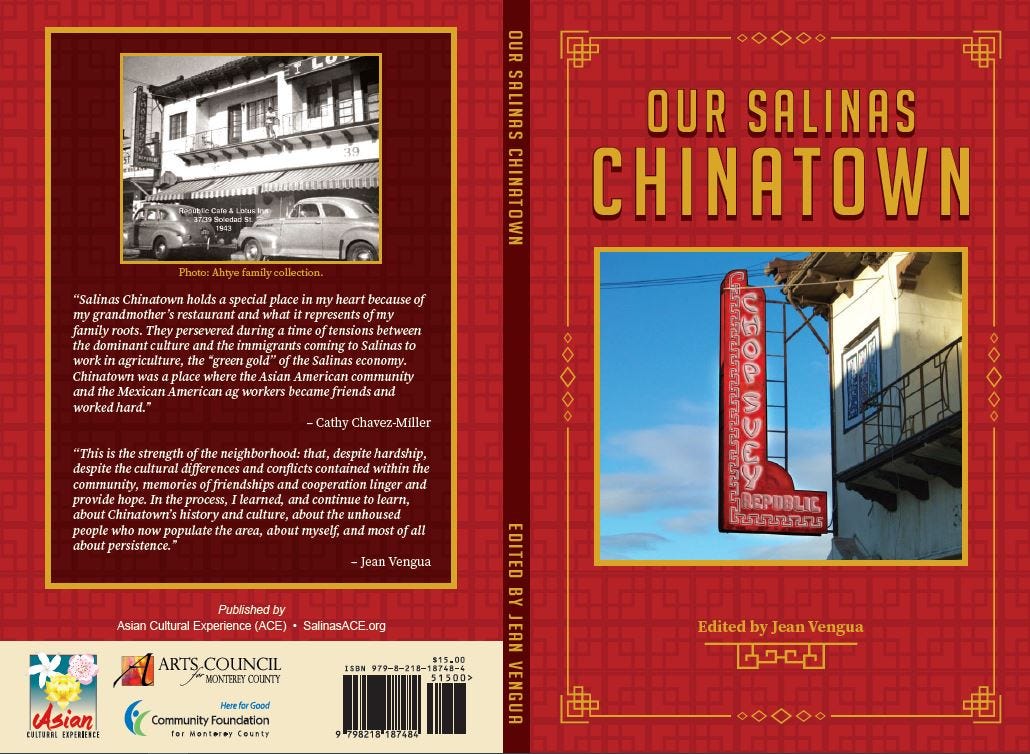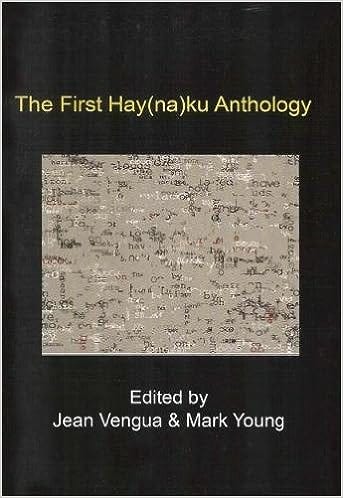The Shape of Memory
#114: A Reading, Eileen Tabios' hay(na)ku, Marlena Myles, Christine Sun Kim, Noel Alumit, Mat Ricardo, Jacob Koopman, and Marlies Koopman
HERE AND NOW
We’re having some overcast skies in the middle of summer, and it’s unusually quiet for a Saturday in this neighborhood. I like the change.
Since going carless, I find myself attending fewer public events. But last night I participated in a release reception for a book I edited, Our Salinas Chinatown, and introduced the readers.
Although some of the memoirs in the book were written by young-to-middle aged people, it happened that all the readers who showed up last night were over 60, so the reading turned into a celebration of older, “trailblazing” Chinatown residents and their stories.
Salinas Chinatown was brought to public attention by John Steinbeck’s novel, East of Eden. The neighborhood was portrayed as seedy and dangerous, and that perception has remained throughout the decades, even though many families with children lived there, among businesses that served both families and immigrant field workers. Besides bars, pool rooms, and a “house of ill repute,” there were churches, union halls, temples, a Chinese language school, markets, a theater, restaurants and cafes, photography studios, auto repair shops, and barbershops—in short, anything an ethnic neighborhood would need to make it a community.
But “Chinatown” was not just for those of Chinese ancestry. It was (and still is) a multicultural community, with residents who were Filipino, Japanese, Mexican, White, and Black, as well as Chinese. In the 1980s, after “urban renewal,” homeless people moved in, seeking shelter, along with services (often run by churches).
The readers we heard from last night complicated any simplistic views there may still be about Chinatown, and I hope they raised questions that are not often asked, like: What happened to the Japanese businesses after all the Japanese families were sent off to incarceration camps? How did their leaving change the neighborhood? How did residents of different ethnic cultures get along with each other in such a compact neighborhood? Why were all the streets made one-way during the 1980s, resulting in the closing of businesses in Chinatown?
WRITING
Usually, I write about visual art in this section. But poetry has been another interest of mine, and I’ve written several collections of experimental poems. Back in 2005, along with poet Mark Young, I co-edited The First Hay(na)ku Anthology,1 a book of poems written in the Filipino hay(na)ku poetic form, invented by Eileen Tabios in 2003.
The name of the form is a play on the Filipino exclamation, “hay, naku!” It’s what you’d say if you were surprised, shocked, or possibly even cursing, like, “What the hell!” So, there’s some humor behind this form, as well as simplicity. It’s wonderfully compact and “portable”—very apt for a diasporic form.
This year, 2023, marks the 20th anniversary of that form. Congratulations, Eileen! She writes that “at least 25 single-author hay(na)ku collections have been released in such places as the U.S., Finland, Macedonia, India, Romania, among others.” The list of hay(na)ku projects is now quite long. She has allowed me to post two of her poems that celebrate that anniversary:
At the Hay(na)ku ‘s 20th Anniversary
Most experimental creations
fall into
obscurity
But not for
experiments with
Love
Useless Wisdom
Only stars outnumber
the buzzing
mosquitoes.
________________
Thanks, Eileen.
Here are the first two stanzas from my hay(na)ku poem, “Loophole”:2
in
the sentence
there is breathing
lost
in space
subject to sentience
The form has a 1-2-3 or 3-2-1 (word count) structure. Try it out for yourself! Check out more of Eileen’s work. Her latest book, Because I Love You, I Become War: Poems and Uncollected Poetics Prose (Marshawk Press), is available through various distributors.
Now I’m wondering about writing some hay(na)ku poems for one of my tiny books. Hmm.
DOWN THE RABBIT HOLE
Gorgeous digital art, designs (check out her beautiful fabric collection), and illustrations from Mohegan/Muskogee artist Marlena Myles:
I had a conversation with my partner about the time when he worked with deaf kids. I wasn’t looking for art relating to deafness, but while writing this issue, I happened to see some videos about the art of Christine Sun Kim (Art 21, Museum of Modern Art):
Writer, artist, actor, and Buddhist pastor Noel Alumit on Dharma and Creativity, or the ethics of a creative life. See also his note on frustration and rejection (32:30):
Given the considerations of right livelihood and art (in Alumit’s view), the next video caught my attention. Performance artist Mat Ricardo asks, “Is art allowed to break the law?” Have you ever broken the law in the process of making art?
SOUNDINGS
More from Christine Sun Kim. “Tour of Captioning the City” with music, visuals, and captions:
Jacob Koopman is a talented, Indo-Dutch street musician with family roots in Java. Here is a day in his life as a busker on the streets of Dublin, Ireland. The “work day” for buskers is probably more complicated than you’d think; it requires a good sense of timing, as well as good relationships with other buskers in the area.
It’s easy to find Jacob Koopman’s music online, which is why I’m going to post a song by his sister Maria Elisabeth (Marlies), who performs a delightful cover, below, of “Santa Monica Dreams” (Angus and Julia Stone). Note: there is some flickering in this video (on purpose) that may be annoying or even trigger epileptic seizures in sensitive people. If that bugs you, check out “She Was Mine,” instead, w/Jacob, Marlies, and Mark V.
Thanks for stopping by. If you’ve a mind to, please share this post.
And if you haven’t already, please subscribe. It’s still free!
My other outposts:
CommonwealthCafe newsletter
My Ko-Fi page (Gratitude for the donations!)
Fediverse:
@jeanevergreen at montereybay.social
@jeantangerine on Mastodon.art and PixelFed (alternative to Instagram)
It was followed by The Hay(na)ku Anthology, Vol. II in 2008.









Glad to see that Alex Fabros, Jr. was able to participate. He’s part of that generation of Filipinos from Salinas who came to the area b/c of Fort Ord.